DO-IT News December 2023
Volume 31, Number 3
Director's Digressions: Moving Forward
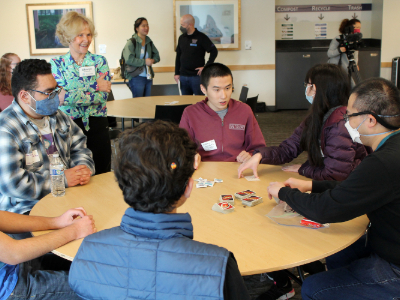
With mixed feelings, I share with you my plan to step down from my position as director of Accessible Technology Services and DO-IT as of December 31, 2023. My passion for universal design and accessibility for all led me to founding DO-IT in 1992, and I couldn’t have found a better home for my career. I leave DO-IT set up for success to continue creating a more accessible world into the future.
In 2024, I look forward to continuing to engage in projects of particular interest to me, doing more writing, spending time with our two grandchildren, and, of course, promoting universal design wherever my path may lead. I am going to miss all of the wonderful people I have worked with over the years, but I hope to stay connected with so many of you, including the participants in DO-IT programs continuing to lead the world into a more accessible future.
For those interested, here is a bit about my journey and the history of what has become ATS and DO-IT:
Although I had already graduated—twice—and worked as a teaching assistant at the University of Washington (UW), my first full-time job with the UW was with the Academic Computing Center (ACC). It was 1984. I came from a faculty-administrator position at St. Martin’s College (now University) in Lacey, Washington. My initial assignment was to build a Microcomputer Support Group to assist faculty, staff, and students who decided it was a good idea to replace their terminals (that connected to the mainframes) with a Macintosh or PC.
My group grew to become Desktop Computing Services. In 1992, during a budget-tight time, I was asked to “dabble” in grant writing, to seek funding to explore the feasibility of Internet use in K-12 schools, show how the use of technology can improve lives, and develop collaborations on campus, particularly with the department of computer science and engineering. My dabbling led to grant and state funding for DO-IT (Disabilities, Opportunities, Internetworking, and Technology). All DO-IT projects serve to increase the success of people with disabilities in college and careers, using technologies as empowering tool; many of them are in collaboration with faculty in the Paul G. Allen School of Computer Science.
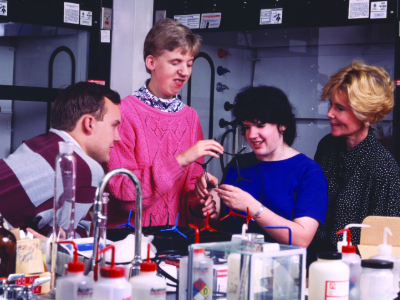
DO-IT has grown substantially over the last 30+ years, becoming housed under Accessible Technology Services over time, when I helped push for more accessibility work to be done both on campus and off. Accessible Technology Services has two outreach units. DO-IT draws in partners on-campus, nationwide, and internationally, whereas the IT Accessibility Team reaches out to UW staff and faculty to join forces to ensure that all the technology the UW procures, develops, and uses is accessible to everyone, including faculty, students, staff, and visitors with disabilities. DO-IT has had a multitude of grant-led programs spanning the United States and even beyond, while, of course, always continuing our capstone program: DO-IT Scholars, which has helped lead hundreds of students with disabilities into successful degrees and careers.
Although I spend much of my time writing and giving presentations, what I will miss most about my job directing Accessible Technology Services and DO-IT is engaging with participants in the DO-IT Scholars, AccessComputing, and other projects. I plan to stay active in the field, so who knows where our paths may cross again.
DO-IT Scholars Create a More Accessible Web
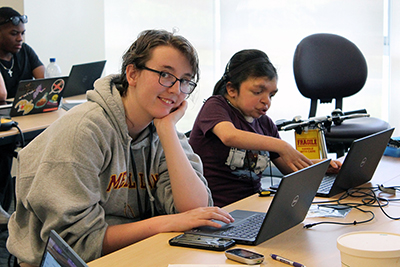
DO-IT Summer study helps Scholars prepare for success in college and careers. Scholars have been coming to the University of Washington campus every summer since 1993 (attending virtually in recent years due to the pandemic) to get a mini experience of what it’s like to go to college. Scholars who came to Summer Study in July of this year participated in a two-week web accessibility class where they learned the basics of how to check websites for accessibility, conducted accessibility reviews of UW websites, and shared their findings with actual UW clients.
Scholars split into two groups and each group was assigned a “client” from the University of Washington community. UW clients included the Meany Center for the Performing Arts and the UW Counseling Center. The Meany Center is a performing arts center located on the University of Washington. The Counseling Center is a confidential mental health service available to all currently enrolled UW students.
Scholars reviewed their respective client’s websites for issues that can impact users with various disabilities in their ability to navigate a web page. They inspected several elements of web pages to assess accessibility including heading structure of web pages, alt text for images, contrast of colors used, and visual indication of focus. Scholars documented issues they found and each group reported their findings out to their respective clients.
Jen Nguyen with the Counselling Center is working in the confines of a website that is part of a larger website to incorporate Scholar feedback, especially with an inaccessible “Need for urgent help” feature for crisis services.
Michaela Marino with the Meany Center is working to update the font size on the website along with improving color contrast, and ARIA landmarks, among other accessibility considerations. They will be diving into user research and explore important conversations about how to make their content more accessible ahead of a new site rebuild.
It’s exciting to see Scholar feedback having a real-world impact. Even though Web Accessibility may not have been their favorite Summer Study experience, Scholars helped make the experience better for people who have barriers to navigating the web.
How to Be an Ally of the Neurodiversity Movement
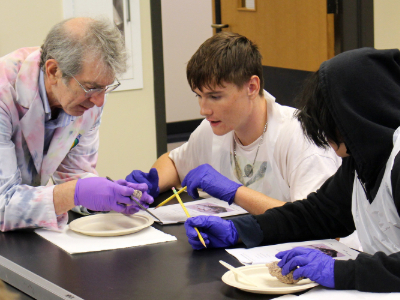
Recognize and understand what Neurodivergent means
A neurodivergent person is someone whose brain, body and nervous system operate differently from neurotypical people. Neurodivergent traits are frequently misunderstood and misinterpreted by neurotypical people and often viewed as aggressive or toxic interpersonal behaviors. Here are a few examples:
- People with autism can be seen as rude or angry or aggressive in their communication due to difficulties in picking up on non-verbal social cues or nuanced communication from neurotypical people.
- People with ADHD are often viewed by neurotypical people as lazy, flighty or irresponsible because they struggle with forgetfulness or go into periods of hyperfocus.
- People with dyspraxia can be seen as careless, clumsy, and destructive due to a number of possible impacts, including impaired fine motor skills, balance, and ability to judge proximity.
- People with auditory processing differences are not hearing impaired but may have difficulty distinguishing the meaning of spoken words without extra time to process or without supplemental input such as captions.
Neurotypical people can start the path to allyship by understanding that these, and other examples of differences in cognitive function, are not signs of low intelligence or intentional behaviors.
Recognize that Neurodivergent individuals choose to identify themselves in different ways
The person-first movement, an example of which might be “a person with Autism”, gained traction in recent years among disability rights movements but particularly in the neurodivergent community, that has never been uniformly adopted and identity-first language is still widely used. Among the neurodivergent communities, autistics in particular view Autism as a part of their identity. This is also true of many individuals who received diagnoses of “Asperger’s Syndrome”. The medical profession has dropped Asperger’s in favor of the Autism Spectrum, but many Aspies still see that as their diagnosis and part of their identity. Note that the Deaf community in particular also prefer identity-first language.
Functioning labels, such as “high-functioning” and “low-functioning” are discriminatory and harmful
Particularly in terms of Autism, individuals usually labeled “high-functioning” often need no, or less support and so are often overlooked. Those labeled “low-functioning” may be seen as incapable of things they can do independently. While these terms are usually applied to autistic people, the implication exists for other neurodivergent people; ADHD is a good example, as some people with ADHD function well without intervention or supports, while others may not. Like everyone, neurodivergent people have a variety of strengths and challenges; needs can vary by day, by environment, by activity. Rather than labeling neurodivergent people by “functioning”, focus on the type of support they need.
Communicate clearly, open communication without pressure and listen
- Many neurodivergent people have a hard time “reading between the lines”. For the neurotypical, communication is full of unspoken understandings. Using clear, plain language and take the time to check for understanding.
- It’s hard for neurodivergent people to initiate conversation, even if they have a topic they need or want to address with you. They just may not be ready. If an ND person is quiet, don’t assume they have nothing to say.
- Give time, opportunity and space, particularly in meetings; listen to the words of the ND person, not their tone or body language. Relaxed or social settings don’t necessarily make communicating easier for neurodivergent; it can sometimes make it harder.
Give misunderstanding time to work itself out
Most often, a communication challenge can be clarified and worked through with discussion. Reframing a situation can be a particularly helpful process. But recognize that communication can require significant energy for neurodivergent people, and they may need a longer timeline – days, or even weeks for complex issues, to work through. This is a particularly important time to avoid negative assumptions; it’s also a time and process when they’re more likely to creep in.
Finally, take responsibility for your own learning
Check out additional resources:
Maya Israel Wins the 2023 AccessComputing Capacity Building Award
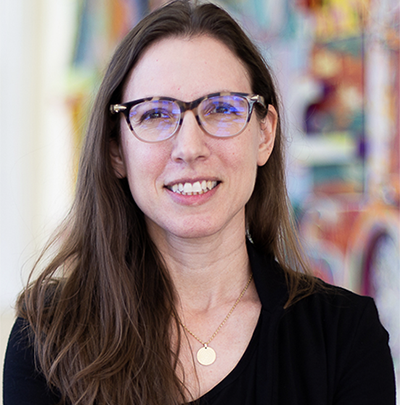
The winner of the 2023 AccessComputing Capacity Building Award is Maya Israel, associate professor of educational technology and computer science (CS) education in the School of Teaching and Learning at the University of Florida. She is the research director of the Creative Technology Research Lab, where she supervises students and postdocs.
For the past ten years, Maya has been a beacon of light, through her research and advocacy, in helping the CS for All community make computer science more accessible and welcoming for K-12 students with disabilities. Her research provides evidence that Universal Design for Learning (UDL) principles can be applied to computer science education to make it more inclusive for all students. Her advocacy has been influential in the creation of CS teacher standards that focus on equity and inclusion of all students including those with learning disabilities. The CS for All community has benefitted from her persistent and wise advocacy for students with disabilities in CS education.
Have You Applied for an NSF FASED Supplement?
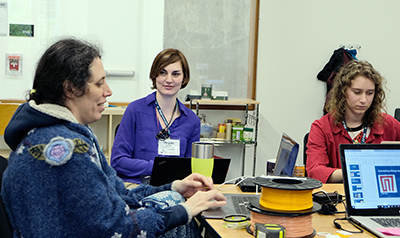
Are you familiar with the National Science Foundation’s (NSF) Facilitation Awards for Scientists and Engineers with Disabilities? Buried in Chapter II of the NSF Proposal & Award Policies & Procedures Guide, is information about the supplements. They were also highlighted in the 2021 Dear Colleague Letter: Persons with Disabilities – STEM Engagement and Access. A FASED supplement can be requested to alleviate barriers to participation in research or training for disabled personnel on a grant, including PIs, other senior personnel, graduate students, and undergraduates.
Funding must be spent on equipment or services that will ameliorate a barrier that is particular to the project rather than equipment or assistance that the disabled person would use in a more general way. Examples given in the PAPPG include: prosthetic devices to manipulate a particular apparatus; equipment to convert sound to visual signals for a particular experiment; access to a special site or to a mode of transportation; or a reader or interpreter with special technical competence related to the project. A wheelchair, hearing aid, or more general purpose device would not be funded.
Requests for FASED supplements can either be included with a proposal when it is submitted or submitted as a supplement to an already existing award and should include information about the specific nature, purchase, and need for the equipment or services requested.
AccessComputing is interested in learning more about how members of our community have used FASED supplements. Have you requested a FASED supplement? Was it funded? What was the funding used for? If it was not funded, why wasn’t it? Email us at accesscomp@uw.edu and tell us more. We hope to use the information we learn to benefit our larger community.
DO-IT Featured in UW's Viewpoint Magazine
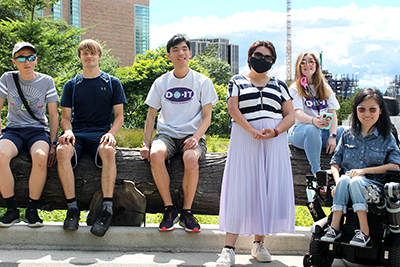
Recently, the DO-IT Center was featured in UW’s Viewpoint magazine. The goal of the magazine is “telling the story of diversity at the University of Washington.” The article shares ideas from three members of the DO-IT community: Dustine Bowker, Kayla Brown, and Sheryl Burgstahler.
The article, appearing on page 4 of the Fall 2023 Issue, is called "Reaching All Learners: The UW’s DO-IT program works to adapt classrooms and labs to be used by all people." The following is an excerpt from the article:
A decade ago, Dustine Bowker went to a pizza party at the Husky Union Building (HUB). Then a junior at Roosevelt High School in Seattle, Bowker, who identifies as being on the autism spectrum, came to the University of Washington to learn about a program designed to help people like him. He’s had to learn to recognize social cues, he said, and adapt to fit into many situations. But at the HUB that day 10 years ago, he felt a sense of belonging. “That was my very first event where I saw dozens of people with disabilities in the same room, and that was a new experience for me,” Bowker says. “It’s a type of community, I guess, that I didn’t even realize was there.”
“One of the biggest influences with DO-IT is learning about disability, how to interact with people with disabilities, knowing about areas like the disability rights movements,” Bowker says. Through DO-IT, he’s made lifelong friends and now better understands that, when it comes to disability rights, he’s building on the legacy of earlier advocates. “I wanted to give back to that community in a way,” he says. “And I think DO-IT has been one of the most profound sources of that.”
To request an accessible PDF version of the article, send an email to doit@uw.edu.
AccessComputing Team Members Complete Their PhDs
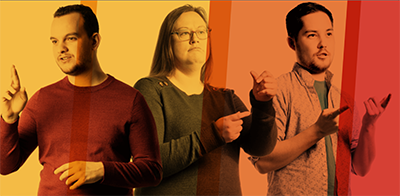
Several AccessComputing Team Members completed their Ph.Ds this in 2023. Congratulations to each of them on this important milestone in their careers! Our first three new Ph.Ds set a major milestone: Abraham Glasser, Noella Kolash and Matthew Seita are the first three deaf Ph.Ds to graduate from RIT.
-
Abraham Glasser received his Ph.D in Computing and Information Studies. His dissertation, “Empirical Investigations and Dataset Collection for American Sign Language-Aware Personal Assistants.” Voice-controlled personal assistants are increasingly ubiquitous, and pose urgent accessibility challenges and barriers for DHH users. Dr. Glasser’s dissertation consisted of parallel research efforts investigating issues surrounding this technology, and provides a basis for future design and development of personal assistants that would be able to understand ASL input. Dr. Glasser started at Gallaudet University as an Assistant Professor this academic term.
-
Noella Kolash received her Ph.D in Computing and Information Studies. Her research interests focus on accessible and educational technology and human computer interaction for Deaf and Hard of Hearing. Currently, she works on improving accessibility for people who are deaf through the selection of culturally understandable icons. Dr. Kolash works as a Junior Full Stack Engineer with the National Technical Institute for the Deaf at RIT.
-
Matthew Seita received his Ph.D in Computer Science His research interests lie in accessibility and human-computer interaction and how Automatic Speech Recognition (ASR) can help deaf, hard of hearing and hearing people communicate better by designing ASR technology that will alert speakers that the software can’t pick them up clearly, which results in errors which lead to deaf people misunderstanding the communication exchange. Currently, Dr. Seita is doing a postdoc with Dr. Raja Kushalnagar at Gallaudet University.
Several other AccessComputing team members either completed their Ph.Ds this year or will complete them before the new year:
-
Aisha Urooj received her Ph.D in Computer Science from the University of Central Florida. Her dissertation, “Visual Question Answering: Exploring Trade-offs Between Task Accuracy and Explainability” explores the process of answering questions about complex situations in videos; the process requires capturing the underlying semantics of actors, objects, and their relationships and their evolution over time (actions). Dr. Urooj examined methods of embedding learning action and relationship in video to solve the video question-answering task. The learned embeddings have the information of implicit graph structure for actions and relationships which significantly benefits in answering complex reasoning-based questions about the video. Dr. Urooj is currently a postdoctoral research fellow in AI at the Mayo Clinic.
-
Brittany Lewis received her Ph.D in Computer Science from the University of Rhode Island. Her dissertation, “Designing Accessible Computing Device Authentication For People With Upper Extremity Impairments” examines how computing device authentication makes assumptions about the user's ability to perform complex tasks with their arms, hands, and fingers. As a result, entering complex passwords, or accurately positioning a camera for facial recognition can create barriers for people with upper extremity impairment. Dr. Lewis said that the goal of her work “was to explore and design more accessible ways for people with UEI to log in to their computing devices.”
-
Jennifer Adorno will graduate in December with a PhD in Computer Science and Engineering from the University of South Florida. Jennifer’s dissertation, “Refining The Machine Learning Pipeline For US-Based Public Transit Systems” focused on improving methods and tools for handling real-time data in public transit research with the goal of decreasing the barrier of entry for data-driven approaches. The research crossed several branches of computer science such as big data, data science, and human-computer interaction. Jennifer is currently searching for a postdoc position focused on accessibility research targeting blind or visually impaired individuals.
- Tee Chuanromanee received their Ph.D in Computer Science from the University of Notre Dame. Their thesis is titled "Designing the Trans Experience: Technology and Common Gender Transition Narratives." Dr. Chuanromanee’s dissertation studies the role of technology in gender transition, in particular, the roles of access, storytelling, and decision-making in gender transition. They currently work as a Human Factors Engineer at Southwest AIrlines in Dallas, TX, and continue part-time as a Research Assistant at the University of Michigan School of Information.
DO-IT Hosts International Visitors
The DO-IT Center gets a lot of calls and visits from people in Seattle, Washington State, and all across the United States. People are curious about our programs, resources, and opportunities. It’s no surprise, then, when international visitors collaborate with us on visits to the University of Washington Campus and DO-IT. This fall, DO-IT hosted visitors from Peru, Colombia, Ecuador, South Korea, and Indonesia!
A visit from Indonesian educators in October was facilitated locally by an organization called the World Affairs Council. The group consisted of five leading disability rights advocates from Indonesia who wanted to explore best practices for inclusive workplaces. They traveled under the auspices of the U.S. State Department, within the International Visitor Leadership Program.
In November, 24 teenage advocates from Colombia, Ecuador, and Peru visited with funding from the Digital Literacy Youth Leadership Program, an initiative of the U.S. Department of State’s Bureau of Educational and Cultural Affairs. The students visited DO-IT as part of a two-week exchange focused on the use of social media to address community issues.
In December, twenty-one visitors from Korea were sponsored by the Korea Education and Research Information Service (KERIS), which plays a crucial role in advancing the integration of Information Technology across all levels of Korean education, from primary to higher education. As a public institution operating under the Korean Ministry of Education, KERIS not only promotes diverse projects but also actively engages in fostering academic research initiatives. They learned about DO-IT’s work related to educational systems, student and teacher supports, and educational technology.
Several staff members shared their expertise during the visits, including Rochelle Bowyer, Andrea Mano, Gaby DeJongh, and myself. For more information, visit the DO-IT International Initiatives webpage.
My DREU Experience with Florida Institute of Technology
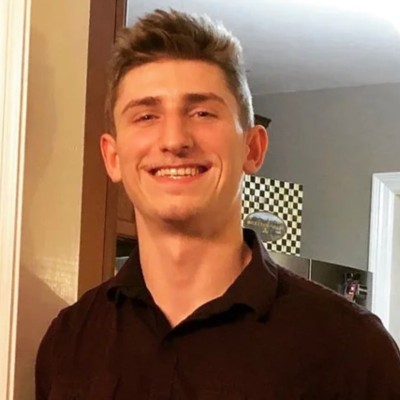
The Computing Research Association's Distributed Research Experience for Undergraduates (DREU) is a program that supports summer research experiences for undergraduate students from groups that are underrepresented in the computing field, which includes students with disabilities. AccessComputing has been partnering with this program for years to pair up team members with a variety of computing labs and faculty mentors.
During my time at DREU, I was involved in three projects: Building a mobile math application, a machine learning suicide prevention project, and ADHD research in the workplace. From the math-app project, I learned value skills in mobile development, and I feel comfortable developing my own mobile app. Additionally, the machine learning team just published a paper on the research we did, and I was listed as an author on that paper. This is a first for me so I am very excited to have something to show people.
The best part of my experience was the remote aspect. Since I was a remote worker, I was able to do my work while studying abroad in Oxford. I wrote code and completed research in England, Italy, and France. I would like to have a remote job out of college and travel Europe, so this was a taste of that lifestyle. I cannot thank DREU enough for the amazing experience, and I recommend this program to anyone interested!
Summer Study: What Do Phase I Scholars Do?
This year, DO‑IT Phase I Scholars participated in a three-week Summer Study session. They learned about college life; explored online resources; interacted with peers, staff, and mentors; and had fun. The DO‑IT Scholars program started in 1993 as an experimental project for teens with disabilities nationwide. While it is usually held on campus at the University of Washington, this year it was held online. It is currently open to Washington State teens and is supported by the State of Washington. The DO-IT Scholars program is supported by all DO-IT staff and led by Tami Tidwell, Kayla Brown, and Andrea Mano.
Technology Update! Fixed, Ten Years Later
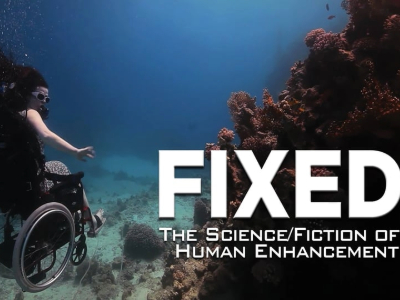
As part of the Phase One curriculum, DO-IT Scholars watch the 2013 documentary Fixed, a documentary discussing the ethics and future of technology accommodating or “fixing” disabled people. Fixed contains many themes and ideas still relevant to today’s world, but it is a touch out-of-date. Much innovation has occurred over the past decade, and technologies that might have once seemed distant are now coming near.
Fixed contained a segment interviewing people on the street about the sorts of advanced capabilities they would want for themselves. In that vein, I asked fellow do-it scholars on technologies they’d like to see in the future or are interested in.
Delivery Drones
The practicalities and convenience of delivery drones is inarguable, however the roll out of delivery drone technologies can be tough- prone to issues or tied up in miles of red tape. Regulations mean it can take a while for companies to get approval for drone deliveries outside of line of sight on an operator, and some difficulties arise in urban environments. Only five companies have gotten an FAA (Federal Aviation Administration) rule 135 exemption (allowed to be out of sight and over people) as of this May, according to Forbes. These issues aren’t insurmountable – federal regulations can be met, and one solution to the urban problem, utilized by the Chinese company Meituan, is to drop off packages at kiosks instead of homes. In the past, much of the applications of delivery drones has to do with the medical side of deliveries, like carrying medicine and blood to hospitals. That is shifting. For a fun and local example, Pagliacci Pizza plans to roll out drone-based pizza delivery for smaller order sizes. Although drone delivery is yet to be commonplace, the technology is getting there, and a future with convenient drone delivery may be in sight.
Flying Cars
This technology is further out than the others, and less applicable to disabilities, but the potential is still interesting to explore. The research and development of flying cars has a surprisingly long history, kicking off with the Curtiss Airplane in 1917 (pictured below, left). It wasn’t much of a success, as might be clearly evident by the lack of flying cars on our roads. I’ll spare you a long explanation of the intervening aerospace history and skip ahead to the present with one major company. Alef Aeronautics, one of several modern companies looking to make the flying car dream reality, is developing their “Model A” (also pictured, right). It has a very recent FAA approval, and they hope to get it on our roads by 2025 (as of December last year) for $300,000. For reference, you can apparently purchase or build amateur recreational planes for far cheaper, although you shouldn’t expect first class. Over a century after the Curtiss Airplane, the sci-fi future dreamt by many has been…lamer than expected, but progress is still being made and perhaps even rather soon we may have flying cars on the road. Of course, they said that about self-driving cars, and look at where we are now.
Self-Driving Cars
For people who cannot drive, self-driving cars could be a lifesaver. For firefighters, they are just a nuisance. In locations with limited self-driving cars can get in the way of emergency response, although they are more of an annoyance than a real danger for the most part so far – with a few notable exceptions, such as the death of Elaine Hertzberg, a bicyclist, in 2020. That car had a safety driver as passenger, but she wasn’t paying attention and the car wasn’t capable of reacting fast enough to the pedestrian. Less seriously, self-driving cars can also clog up traffic as they struggle to manage more complicated situations. Despite these setbacks and poor public press, many taxi companies, such as Waymo and Cruise, are expanding. Very recently efforts in San Francisco to expand the Waymo driverless taxi service to be a 24/7 service has generated controversy. Perhaps someday driverless cars will be ubiquitous, but there’s still many limitations to be worked out.
Mind Reading
Personally, I have no clue why people wish they could read minds. That feels like a pretty steep invasion of privacy to do so casually, and I’d really rather not know what people are thinking about. Still, fair is fair, and this topic was a request. I’ll look at a few related ideas.
Mind to Text: Guess what? Chat-GPT is apparently good for more than just cheating on schoolwork… or whatever else people do with it. AI Technology has been recently used to create a less invasive method of “reading minds” – decoding data from MRI scans to construct full sentences to a reasonable degree of accuracy. The days of requiring implants or electrodes to record people’s internal thoughts are soon to be over, although the technology has some limitations. It’s certainly not the era of dystopian monitoring- the technology is not portable, requiring huge machines to work. It needs to be taught to adapt to a specific person’s brain to be accurate, a process that takes a long time. Still, through the power of AI, this technology has made recent bounds and may provide a useful way to provide speech to people who cannot talk in the future.
Mind to Computer: This technology was discussed in Fixed, I believe, all the way back in 2010. More recently, the start-up Synchron hope to achieve a less invasive interface that doesn’t require brain surgery- by connecting the interface through blood vessels rather than directly through the brain like companies such as Neuralink. This sort of procedure is considered much less risky than procedures that involve messing with the brain, so much so that they received FDA testing approval on humans before the highly publicized and well-funded Neuralink (owned by Elon Musk). Because the surgery isn’t brain or skull surgery, it can use less specialized doctors and be more accessible to a wider group of people. The neurotech is showing promise – pictured below is a tweet by a patient (“phil”) with ALS who used the implant to control a computer. Brain-Computer interfacing through vein implants seems strange, but it could make the technology safer and more available than in previous years.
Fixed did a stunning job of remaining relevant, but I doubt it could have predicted the kinds of advances made in the past 10 years. What kind of technologies would you like to see?
Invisible Disabilities
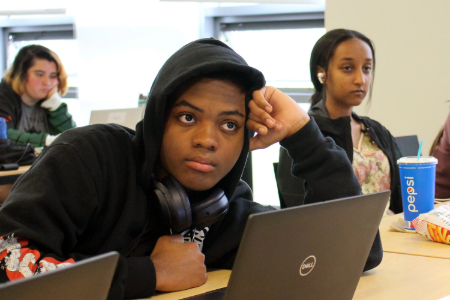
When I was a child, it was very difficult to sit still and be calm; I was always moving around and couldn't sit still. This could have been blamed on me being young but even as I got older I could not sit still. PI and others always wondered why until I got diagnosed with ADHD which affects my ability to focus especially in school. I have a disability that can’t be seen and it has completely affected my life in multiple ways.
When I found out about this as a child I didn’t think much about it but as I grew it really affected how I thought. Since I always moved around and struggled with paying attention in school people always made assumptions, it was always “stop moving so much” or “you’re weird” and everyone always wondered why and so did I. I always questioned why I was like this and said sorry all of the time and when I found out why I always disliked myself for it.
I never realized why and how it worked and as a child always blamed myself not knowing I couldn't help it. I was so scared of what people thought about me judging me until I was able to explain who I really am. I was too scared to speak up and advocate for myself so I just hid myself. My disability was not just invisible to others but invisible to me as well, that's because I ignored it and never accepted it as a part of me. I always thought I was “weird” or not “normal” but as I grew older I realized the truth.
I started taking medicine for my ADHD and it helped me calm down. But in school I had accommodations like being asked if I needed help out of nowhere and easier work. Even though I never liked it because other kids were not asked this I did need it at times I still hated it, why I hated it was because other kids did not need it and I wanted to be like them and be “normal”. But as time went on I realized I'm not just my disabilities, I'm smart and kind no matter what.
I realized what I did need and what I didn’t. So as I grew up I was able to confidently tell people why I'm like this and why I act like this, I became a stronger person saying what I wanted help with and what I didn’t. I was able to accept my disabilities and lived with them not letting them discourage me anymore, becoming stronger every day. So what I can say to everyone like me with invisible disabilities being judged without knowing why, don't be discouraged, keep pushing with no one stopping you from believing in yourself and your abilities.
Accessing Food
Food is the natural way to anyone's heart. We all need it to survive but also crave different types of cuisine. However, the path to food can also be a closed and barricaded door to those with allergies. I am one of those people.
For me, it is essential to learn how I will be able to access food. I don't want eating to just be a chore; I want to enjoy my food. During the DO-IT in-person week, I advocated these difficulties.
Notably, when I went to get my first breakfast, I was pleasantly surprised that each item had the main ingredients listed concerning significant allergies. Unfortunately, however, there wasn’t any indication of the ingredients other than the most common ones. Because of that, I could not know if items had some of my less common allergens, creating a lack of certainty when eating food.
Unfortunately, the morning after, the breakfast food was unmarked and unlabeled; this continued into most days.
More guesswork was needed, and I had to use my ability to smell to understand what was in each bowl. This impacted me by being unsafe to eat, which resorted to me only eating fruit, salad, and snacks from the store.
I spoke up that I could not eat anything but salad. This helped immensely. During the following food period, I had separate food that I could eat, which was filling.
Later the chef came out to speak with me about my allergies.
Finally, I could eat enough food through the DO-IT program.
Born to Run
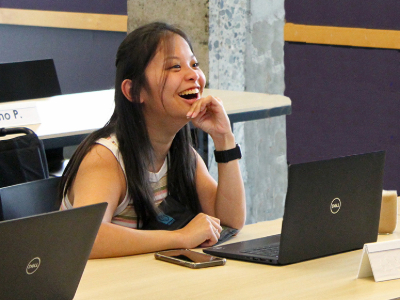
“I wish I could run faster.”
“I wish I looked normal.”
“I wish I could move like her.”
“I wish I could talk like them.”
No matter how much I wish to live a life of normality, it is only wishful thinking. October 6 is National Cerebral Palsy Day, but for me… every day is Cerebral Palsy Day. I never knew life without cerebral palsy.
Cerebral palsy was the reason I lived in a Chinese orphanage for the first seven years of my life, and it was the reason some strangers from America asked for videos of me. Why? They were worried they couldn’t provide for a little girl with CP. When they saw the video of a girl picking up tiny pieces of a puzzle and putting it together, they could tell I was focused and determined. That determination helps me get through life.
Sitting in my new room, I intently watched as one of my parents showed me how to tie my shoes. I memorized every movement.
“Let me try,” I said. Cris cross, pull it under, pull away, one bunny ear.
Cris cross, pull it under, pull away, one bunny ear. “I’ll try making a bunny ear with my other hand.”
Cris cross, pull it under, pull away, one bunny ear, wrap the other string around… pull it through. “Oh, come on!”
Cris cross, pull it under, pull away, one bunny ear, wrap the other string around, and pull it through.
Cris cross, pull it under, pull away, one bunny ear, wrap the other string around, pull it through, but not all the way, and pull the bunny ears tighter. “I did it!”
The sun shined bright and hot as I stood and waited for my events at the elementary track and field practice. I read the list of events and started to sweat. I couldn’t tell if the sweat was from the heat or nerves; it was probably both. The track meet was only a week away, and I was terrible at all the events, especially running.
“What am I doing? I can’t run. I will definitely be in last place. I’m too short and slow. I also look weird when I run. Everyone is going to watch me.”
On the day of the track meet, all I wished was not to finish last in the 50-meter dash. I headed over to the starting line, feeling nervous. “Welp, I think it's too late to back out now. I can do this.” My breathing quickened as I got ready. Doubts filled my head. I heard the gun and started running. Everyone was already ahead of me, and I was starting to feel tired, but I had to finish this race. When I reached the finish line, for a moment, I was disappointed … until I heard cheering. I looked back, and there was still a girl behind me. I squealed in excitement.
On a daily basis, whenever someone glances at me, they can see how I walk or run. You can imagine I look a little different, but until they hear me talk, no one realizes that my disability also comes with a speech impediment. Walking and running is something I just do. I don’t have to think about putting one foot in front of the other. I just do it. It’s different with my speech impediment, though.
“Roll your tongue to the back of your mouth!” Jenna instructs, pointing to a picture of a car, which is a word with an R in it for me to pronounce. If I say it wrong, I have to say the R sound over and over again until I get it right. It’s repetitive torture, but I know she is training my brain to make my tongue work right.
I have to concentrate on connecting my brain to my tongue so that every part of a word sounds crisp. It’s kind of like my tongue has a mind of its own sometimes. Ever since my first year in America, I’ve been going to speech therapy. Even though I get frustrated sometimes, I know this will benefit me. I won’t fully speak normally, but if I get better at pronunciation, then people won’t feel uncomfortable because they’ll understand me more easily.
I have started to think about the future and how I can go through life independently. “Oh my gosh, what am I going to do if I can’t even provide for myself? No one is going to accept someone who's different.”
My dad wanted me to meet a friend of his one weekend. We drove an hour or so to meet her. We were on Oregon State University’s campus waiting for her.
“I wonder what she’s like.”
As she came closer to us on her scooter, with her service dog, I started to see why my dad wanted me to meet her. She had CP, too.
“This is Shelley,” Dad introduced her.
My mom and my sister introduced themselves and me. The adults began a conversation, and I realized Shelly had a speech impediment, too. After a while with her, I wondered so many things. My dad asked questions about Shelley’s life for my benefit, knowing that there were so many questions running through my head.
After talking with Shelley, I felt more confident about my own future. Shelley had a successful career and lots of friends who supported her. Looking at Shelley’s life, I know whatever the future holds for me, I will have people who will support me and give me chances to prove myself.
I know that I still have a lot of time ahead of me. Life won’t be easy, but I just have to keep moving forward. People might discount and overlook my abilities. Doubts and worries will come along, but if I stay determined and dedicated, I can do what I want to do and be who I want to be. My wishes can’t be granted, but I can make the best of what I was born with. I look forward to how the DO-IT Scholars will help me along the way.
DO-IT as a Service Dog
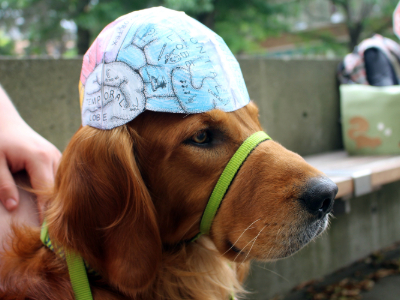
At the beginning of the summer, my mom, Becca, got me a fancy new vest. When I got this new vest, my mom started taking me with her more and more when she left the house. Usually it was just for a car ride, but sometimes I got to go to the park, the store, or just on walks.
After a few months of wearing my new vest, and learning new things to help my mom, we went on a long car ride into a busy city. We arrived at a huge place, with lots of new things, and tall buildings. There were so many new people and smells, but I did my best to stay on task and help my mom as best as I could. At first I was a little overwhelmed, but my mom and I helped each other keep calm.
The best part of my new vest is that it allows me to go everywhere with my mom, which I love, because I get so lonely whenever she leaves me at the house. Now that I get to go with her everywhere, I get to meet lots of new people. Almost everybody likes to pet me, and I did my best to win over those who didn’t. This week alone, I made so many new friends, and got so many cuddles, but only when my mom said I could. I also took a lot of naps.
My new friends all look different, and some sound different too, but I still go see them when they say my name, “Charlie.” A lot of my new friends have cool chairs that make it so they don’t have to walk. Some have an extra metal leg, just like my mom, and some even have more than that. Even with all the new things, I didn’t get scared or nervous at all. I was as careful as I could, but sometimes my mom had to correct me.
This week was pretty exhausting, but I learned a lot, and I loved it. I got to go on so many walks, which I loved, even though I couldn't chase the squirrels or birds. When people got upset, or stressed, my mom let me help people besides her. Lots of my new friends calmed down when I was nearby, and I could feel it.
This was the best week of my life, and I wish everyday was like this. My mom says I have to wait a year to do this again, but I know we’ll have a lot more adventures in between then and now. I get to go to some place called “High School,” whatever that is. Next year when I come back, I can’t wait to see my old friends, and to make some new ones.
My Disability and My Hobbies
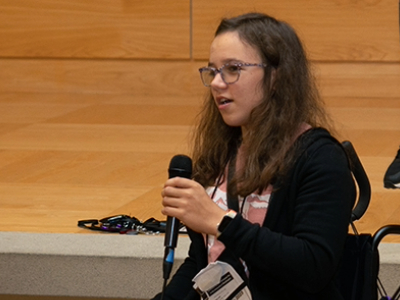
My Disability and How DO-IT Has Helped Me
I have spastic diplegic cerebral palsy and use a walker most of the time and a wheelchair for longer distances. I joined DO-IT to find people who were also members of the Disabled community. I love DO-IT, one of my favorite sessions was Disability Identity which was led by Kayla Brown. We covered some of the history surrounding disability such as the passing of the ADA in July of 1990 and the 504 sit-ins. Along with that we also talked about the two models of disability, which are medical and social. Hearing about these two models helped me redefine my identity in relation to my disability. Along with the extremely informative sessions, DO-IT is a place of understanding. There is this solidarity, and you can be yourself without judgment. I love this program!
My Hobbies
I have been singing in choir for six years and have been doing voice lessons since February of 2021. I love the act of singing and music in general. It is a way for people to express themselves, tell stories, and connect with others. I also listen to music constantly when I am alone. I almost always have my noise-cancelling headphones on and play music on my phone - it makes me so happy and gives me so much energy. Another hobby I have is writing. I have been writing for as long as I can remember. I spent most of my lunch breaks in middle school writing. I love being able to escape into a different world – I do write realistic fiction. I have been working on a story of mine since July 2021 which is inspired by the fact that July is Disability Pride Month to celebrate the passing of the ADA. I love it. I love being able to tell stories and seeing myself represented – some of my characters are disabled.
Ranking of Closed Captions Formats in Movie Theaters
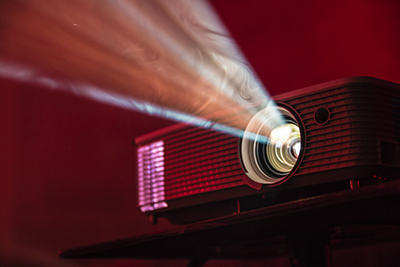
As a movie-goer who is hard-of-hearing, I have had many experiences with captioning formats used throughout various movie theaters. From the good, the bad, and the meh, I’ve decided to rank the three most common versions of captions that I’ve used in theaters.
3. Cup holder captions
As implied by the name, this style of captions goes into the cup holder of your seat. The issues I have with this is that I find myself looking back and forth between the captions and the screen, which can become a bit annoying after a while. Looking back and forth between the captions and the screen can also cause me to miss out briefly on what is visually happening in the movie, which can become a problem depending on the scene. Until humans develop the ability to have one eye focus on one thing and the other looking at something else, the cup holder captions will remain my least favorite.
2. Glasses captions
Glasses style captions are regular glasses that display the captions in the movie in a transparent, typically green font. The pros of this style of captions is that since they are glasses, that means that when one is wearing them it allows the captions to be displayed on the screen. This helps fix the problem that I experience with the cup holder captions, However, it can be a struggle to set them up to where you want the captions to be placed, and I’ve also noticed that some of the dialogue can be cut off if you don’t place it correctly.
1. Open captions
Open captions is when the dialogue is displayed on the screen itself, no glasses or cup holder needed. The reason why it takes the number one spot on my ranking is that since the captions are on the screen, there is little to no technical difficulty/difficulty seeing them. The only issue, which is more of an industry issue rather than the captions themselves, is that not all theaters have them. However, with the difficulty that I and other deaf and hard of hearing people experience with the other closed captions devices, open captions are the easiest and smoothest way to watch movies in the theaters. Open captions are not only beneficial to those who are deaf and hard of hearing, but people who have auditory processing disorders, and movies/scenes where the dialogue are hard to understand. Fortunately, large chains such as AMC and Regal have open captions showings for movies across many of their theaters. However, there’s still work to be done to have open captions showings of movies in theaters in at least most of the US.
What's Your Favorite Hobby?
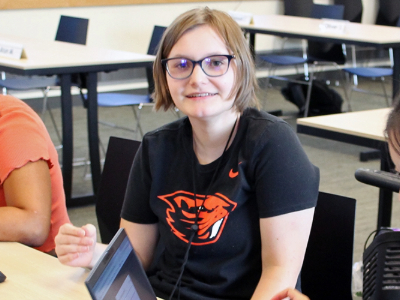
The best part about DO-IT for me or any other camp is getting to know the other scholars there and what better way to get to know a person than to ask them about their hobbies. For starters I am going to tell you a little bit about mine and then I will share with you some of the other students' hobbies.
I have many hobbies, but my favorite that I could go on talking about all day is writing. I love to make up characters and develop them into a story and or just create a playlist for them. My favorite character is Chandler, who is the character that I am drawing in the picture. He is my favorite because I like his hair and his style. He is also a very sarcastic character sometimes.
Now that you know a little bit about my hobbies, here are some other scholars’ hobbies and also some stuff.
The first person was of Tami. Who says “My number one game is Minecraft.” She has been playing it since August of 2020.
Then the other person was a scholar named Eric. He loves to do chess, basketball, swimming, and anything to get his body exhausted. He said “I just like to work myself”
Then the last person that I interviewed and to know throughout the week in person during DO-IT was Julia. Her hobbies are swimming, writing, and singing. Why she likes those hobbies is because of self expression.
As you can see from what I have shared. The DO-IT Scholars from 2023 have a wide range of hobbies and interests. I have enjoyed hearing and learning about them throughout the time we got at DO-IT.
A Culinary Adventure at the DO-IT Dinner
On July 26th, while out with DO-IT for dinner, I decided to sample almost everything that was available in the all-you-can-eat buffet. This is my review of what was available that night.
I tried a variety of main entrees and sides. The first thing I tried was the chicken nuggets, which I really liked. They were tender on the inside, and nice and crispy on the outside. I rated them a 10/10 on my scale. Next, I tried the Turkey Sandwich, which was okay. There was nothing that stood out about it. I gave it a 5/10. I then had a salad, which was pretty tasty, but there was too much dressing. I rated it a 7/10.
Then I wanted to explore all the dessert options. I first tried the chocolate cake. I really liked it, because it was nice and chocolatey. I gave it a 9/10. Then I tried the Banana Cake, which I LOVED. The frosting pushed it over the top. It was a 10/10. I had the coconut chocolate cake, which was okay. I didn’t like the coconut flakes though and rated it an 8/10. I then tried the Lemon Bar, which I LOVED. The powdered sugar sent it over the top. It was a 10/10. Next up was the fruit bar, which I didn’t like. I couldn’t taste the fruit, and it tasted more like bread to me. I rated it a 4/10. I then tried a brownie, which I rated a 5/10 because there wasn’t enough chocolate. I finished with a caramel candy, which I really liked; it had nuts in it and was covered in crumbs. I rated it a 10/10.
In conclusion, most of the food is really good, and I appreciated the experience in trying a variety of foods.